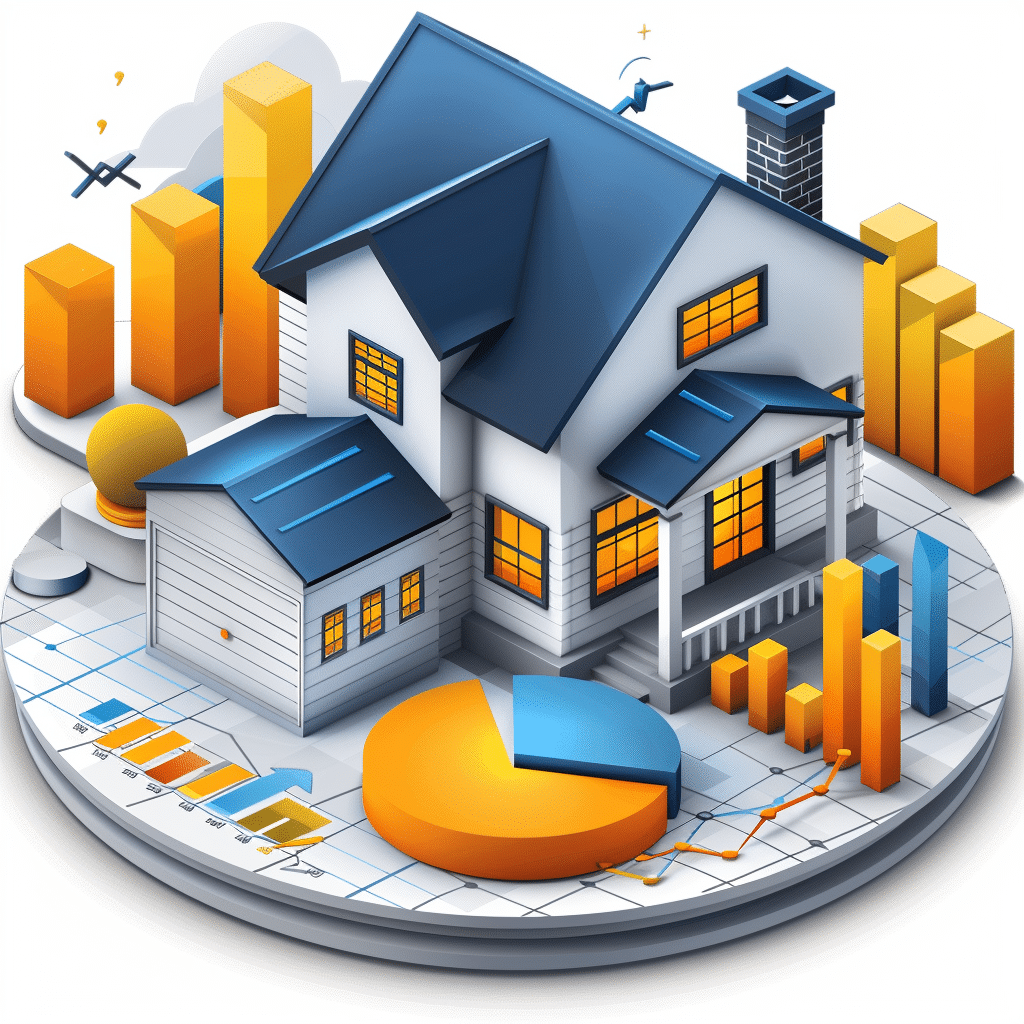Understanding mortgage rates graph trends is not just about looking at zigzag lines on a page. It’s unlocking the story of our economy, the heartbeat of the housing market, and the map guiding us towards smart financial decisions. So, let’s buckle up and take a deep dive into the ever-fluctuating world of mortgage rates, shall we?

Deciphering the Mortgage Rates Graph: Key Points Throughout History
Mortgage rates graphs are like history books, except they use curves instead of words. Starting in the tumultuous days of the 1980s, when interest rates soared sky-high, these graphs show us how homeownership has been a rollercoaster ride. Then came the introduction of adjustable-rate mortgages (ARMs), widening options for buyers but adding a pinch of unpredictability to the mix.
The 2008 financial crisis? Now, that was a chapter of its own. Mortgage rates took a nosedive as the world grappled with credit crunches and bailouts. The aftermath saw folks scrambling to refinance, as shown by jagged dips and peaks on our historic mortgage interest rates graph.
Fast-forward to more recent times, and we’ve seen the pandemic paint a wild picture. With record-low mortgage rates, the graph sloped downward, inviting a boom in home buying despite the world being otherwise upside down. Analyzing these patterns not only informs us about the past but equips us for the future.

Analyzing the Current Mortgage Rates Graph: What the Trends Tell Us
Alright, friends, zooming in on today’s mortgage rates graph, it’s clear we’re in a different landscape. Picture this: from the valley of low rates during the COVID-19 era, we’re now ascending the hill, with rates ticking up again. Word on the street is, we can thank (or blame) economic recovery and inflation fears for this upward trend.
But let’s get real. This isn’t just about lines on a graph; it’s about the blood, sweat, and tears behind each mortgage application. And with today’s rising rates, the monthly mortgage bill might just pack a heavier punch. Special mention goes to geopolitical puzzles that also stir the pot, like conflicts and trade tiffs that have lenders and borrowers playing a game of financial chess.
Peeking at the mortgage rates chart, savvy folks ponder,Will these trends steady or spiral? That’s the million-dollar question. These graphs aren’t just squiggles; they’re signals, crystal-balling the market’s mood swings for anyone with skin in the home-buying game.
| Year | Average 30-Year Fixed Rate | Average 15-Year Fixed Rate | Notes |
| 2023 | 6.25% | 5.75% | Rates increased due to inflation concerns. |
| 2022 | 5.50% | 5.00% | Economic recovery led to higher rates. |
| 2021 | 3.00% | 2.75% | Record low rates due to stimulus measures. |
| 2020 | 3.75% | 3.25% | Initial impact of the COVID-19 pandemic. |
| 2019 | 4.00% | 3.50% | Stable economic conditions before pandemic. |
Mortgage Rates Graph Predictions: Modeling the Future Landscape
Peering into the crystal ball, what might the mortgage rate landscape look like tomorrow? Here’s where we get technical. By crunching numbers, and I mean serious data from the brains at JPMorgan Chase, and the Federal Reserve’s economic prophecies, we paint a picture – no, a forecast – of where rates might head.
This isn’t fortune-telling with tea leaves; it’s data-driven predictions. We’ve got analysts running simulations, factoring in everything from inflation to whether people are falling over themselves to buy homes. It’s a modern-day oracle, if you will, turning today’s economic pulse into tomorrow’s fixed rate history trends.
Interpreting the Mortgage Rates Graph: A Tool for Strategic Planning
I hope you’re ready to roll up your sleeves because it’s time to talk strategy. If you thought mortgage rates graphs were just for bigwigs in suits, think again. They’re a goldmine for everyone from Joe and Jane Homebuyer to the big dogs at Zillow.
For those eyeing a home purchase or sale, reading these graphs isn’t just about now vs. later. It’s about potentially bagging a deal or padding your nest egg. Timing is everything, and with a handy mortgage rates graph, you can try to hit that sweet spot where the rates tug at your wallet just a tad gentler.
Real estate giants and mom-and-pop buyers alike are gleaning insights from these graphs. By figuring out the lay of the land, or shall I say, the “line of the graph,” they decide when to make their move. Hold tight or leap now? The graph spills the beans.
The Relationship Between Mortgage Rates Graph and Real Estate Market Health
Here’s a nugget of truth: health isn’t just measured by how many push-ups you can do; it’s also about the real estate market’s pulse. The ups and downs of mortgage rates are like a stethoscope to the chest of the housing world. When rates climb, wallets tighten, and those dream homes might just slip out of reach for some.
Cities like San Francisco and New York have seen this firsthand. As rates go up, the feverish market frenzy cools down to a chill. It’s all interconnected – a domino effect. Mortgage rates graphs aren’t just charts; they’re a vital sign, a beat that every homebuyer and seller feels in their bones.
Mortgage Rates Graph Innovations: Advancements in Data Visualization
Guess what? Sifting through mortgage rate trends isn’t as snooze-worthy as it once was. Thanks to tech moguls like Microsoft and Google, we’ve now got data visualization that’s spicier than grandma’s escarole soup.
Gone are the days of static, snoozy graphs. In their place are dynamic, interactive beauties that sing and dance to your swipes and clicks. Want to know how rate changes affect your neighborhood? There’s a graph for that. Wondering how different loan terms play out in real life? Yep, there’s a graph for that too. It’s like having a mortgage rates crystal ball right at your fingertips.
Connecting the Dots: The Broader Economic Implications Reflected in Mortgage Rates Graphs
Now, let’s not forget, mortgage rates graphs aren’t in their own little bubble. They’re tied to the grand tapestry of our economy – from how many folks have jobs to how much we love shopping. A spike here, a dip there, they all point to not just housing trends but the confidence and cash flowing through our veins.
Connecting these dots is like solving a riddle. But instead of a prize, you get clarity on the big picture – where is our economy heading? Loan lenders aren’t just crunching numbers; they’re reading the signs, from Silicon Valley’s latest profits to rust belt factories’ output. All these heartbeats of our economy make their mark on the mortgage rates graph.
Leveraging Mortgage Rates Graph Insights for Personal Financial Growth
Let’s come down to brass tacks. Whether you’re eyeing a shiny new abode or pondering a cash-out refinance, mortgage rates graphs are your best bud. This isn’t just academic; it’s about your bank account’s health and happiness. Being a mortgage rates graph whiz means dodging bullets and catching opportunities.
Planning a home purchase when rates dip could save you a pile of cash so big you won’t know where to stash it. Considering a refinance could lower your monthly dues, freeing up some greenbacks for that mid-life crisis motorbike or, better yet, a nest egg that would make even the Hottest Guys in finance jealous.
Harnessing Historical Data to Navigate Future Mortgage Landscapes
So there you have it—a journey through the crests and troughs of mortgage rates graphs, with some tangible takeaways for your financial playbook. But this isn’t just about riding the wave of mortgage trends; it’s about steering your own financial ship through storms and sunsets alike.
By combing through the archives, staying alert to today’s whispers, and forecasting tomorrow’s rumblings, you can become a mortgage rates graph guru, positioning yourself for not just a bargain on a loan, but a flourishing financial future. Keep an eye on that graph – it’s more than lines and numbers; it’s the ink with which you can write your financial destiny.
A Peek into Mortgage Rates Graph Trends Over Time
Hey folks, let’s buckle up for a roller coaster through the world of mortgage rate graphs. Ever looked at one and felt like you’re trying to decipher ancient runes? Well, you’re not alone! These graphs can be as twisty as a plotline from our favorite fiery princess Rhaenyra targaryen, with spikes and dips that could give anyone’s heart rate a run for its money.
Graphs showing mortgage rates over time are like a kaleidoscope, you know? They show a dazzling array of historical patterns that can leave your head spinning. Did you know in the ’80s, rates were as if they were trying to scale Mount Everest, peaking at what now seems an almost ludicrous 18%? Now, that’s a steep hike without a sherpa! In contrast, today’s rates might seem like they’ve had a bit too much chill pill, sometimes lounging in the low single digits. It’s like we’ve gone from a heart-pumping threesome of high digits to a cozy, more manageable party of two—or less.
Now, let’s take a quick sidestep and talk about stability, or sometimes the lack thereof. See, these graphs aren’t always the “steady as she goes” type; they’ve got more mood swings than a lesbian mature romance novel. Economic factors, political events, global pandemics—you name it, they’ll shake up mortgage rates like a snow globe. Remember the 2008 financial crisis? Oh boy, mortgage rate graphs from that time look like they’re throwing a tantrum.
But hiccup, let’s not get too bogged down with the doom and gloom. Nowadays, with all the tech at our fingertips, predicting where rates will go next is a tad easier—it’s like having a crystal ball, only with more numbers and less wizardry. And talk about a party trick! Whip out your understanding of mortgage rate trends at your next dinner party, and you’ll be the life of the party—or at least the economy nerd corner.
So, why should you care about the zigzags of mortgage rates over time? Because, my friend, those seemingly random squiggles can save or cost you a small fortune when buying a castle—I mean, house. Understanding the trends can help you lock in a rate that keeps your wallet happier than a dragon on a pile of gold. And isn’t that what we all want? To be a little more like a treasure-hoarding, winged-beast, secure in our financial dens?




